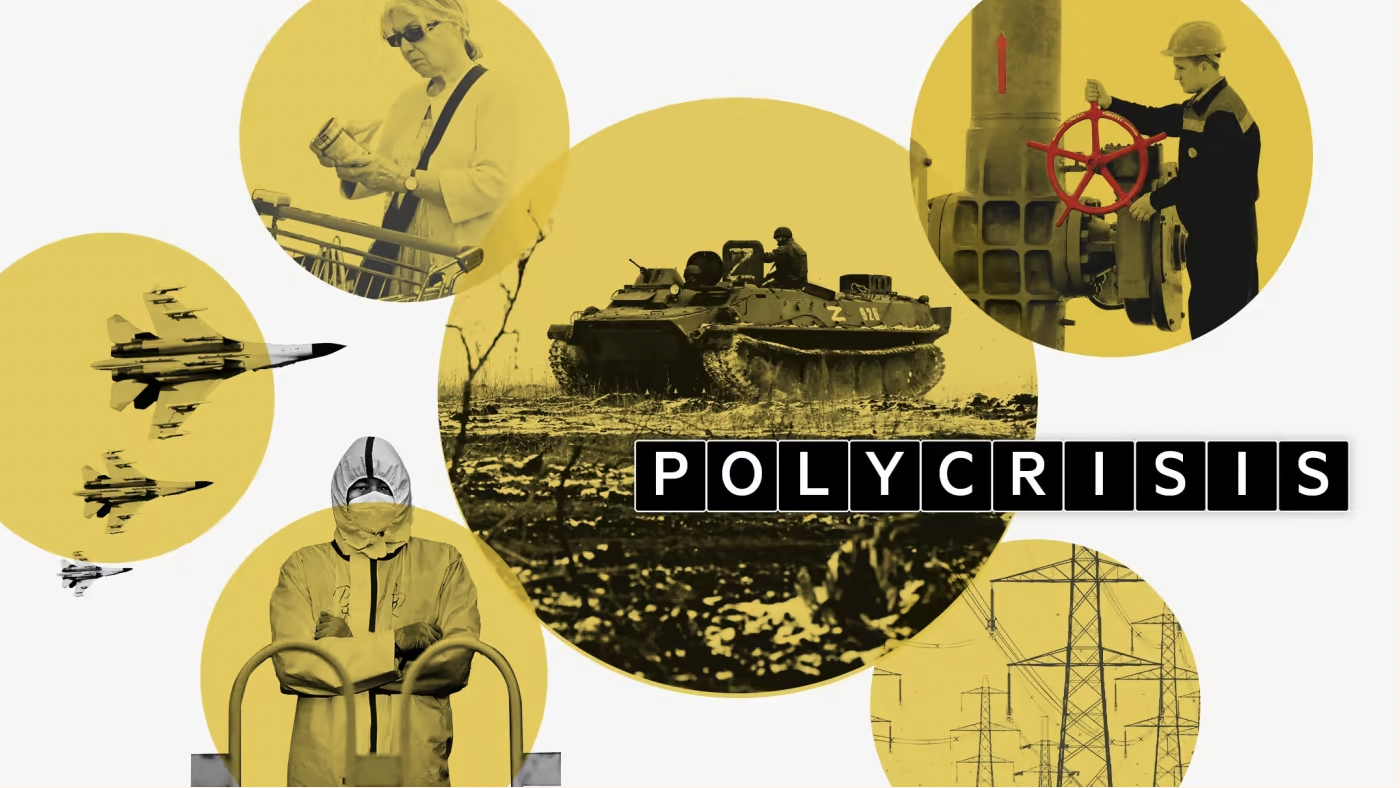Grappling with Global Challenges in an Era of Polycrisis
There’s no doubt about it, the world is in crisis. Between the climate disaster, financial hardship, the soaring cost of living, a global pandemic, global food insecurity, the rise of dictatorships, political polarization, the existential threat of nuclear fallout, and what seems like war after war after war, just to name a few. Often, it seems like these issues only build off of each other and our world finds itself caught up in a tangle of millions of feedback loops, perpetuating our collective plights. Now, it seems we have a word for this phenomenon – a “polycrisis”.

The term “polycrisis” was coined by French theorist of complexity, Edgar Morin, in the 1970s, and popularized by Columbia University professor, Adam Tooze. A polycrisis is defined as “an inflection point when disparate crises interact such that the overall impact far exceeds the sum of each part”. The word has gained more traction over the last year, when the term became a topic of discussion at the World Economic Forum (WEF) in Davos, Switzerland. WEF has long been a platform for some of the world’s most powerful people to discuss society’s imminent issues. Each year, tech giants like Meta, companies like ING and Deloitte, and countries like India and Ukraine host panel discussions and interviews with keynote speakers who discuss the world’s most pressing threats. At Davos this year, panel discussions were held regarding the idea of a polycrisis and how an ever-complex world is set to deal with them.

In WEF’s Annual Global Risks Report (pictured in Figure 1), experts found that the risk of an emerging polycrisis is growing, listing the 10 greatest short- and long-term crises that the world is facing. Listed in order for short-term were the cost-of-living crisis, natural disasters and extreme weather events, geoeconomic confrontation, failure to mitigate climate change, erosion of social cohesion and societal polarization, large-scale environmental damage incidents, failure of climate change adaptation, widespread cybercrime and cyber insecurity, natural resource crises, and large-scale involuntary migration. As one can imagine, the result of these factors if they go unchecked, is likely catastrophic.
Much of this can be attributed to our extraordinarily interconnected society. Trade opportunities have never been greater, while the exchange of matter, energy, information, and organisms is growing exponentially. Not only that, but humans simply have access to more information than ever, which can completely overwhelm us and make it feel as though a polycrisis is underway. The extremely high connectivity of ecological, social, and geoeconomic systems lends itself to extreme vulnerability, allowing a singular disruption to move rapidly throughout the systems, creating a domino-like effect.

To help grasp the term, consider the following. Russia’s full-scale war against Ukraine (waged at the beginning of 2022) sent food and gas prices around the world into a spiral. These rising prices of basic necessities fuelled the ongoing cost-of-living crisis, creating social discontent and political polarization, especially in the West. This crisis worsens political polarization in the US, which looks like it may be heading into decline, despite its objectively enormous role in the 20th century. The idea of high global connectivity is illustrated in Figure 2, picturing links among the world’s most pressing problems. Because of the interconnected nature of the world’s polycrisis, we are entirely unable to point to a single root cause and therefore a single root fix, begging the question of how we get out of a polycrisis.
This cascade of converging factors cannot be attributed to just one problem and can’t be solved by passing a piece or two of legislation. Though many find hope in “sweeping solutions” like social revolutions or political movements, there is no single solution to this issue because there is no single cause. Solving these issues takes an extremely focused and multifaceted approach, attacking all sides of the problem at once.
According to experts, there are a few main approaches that must be taken to combat the ongoing polycrisis. The long-term existential threat of climate change needs to be top of mind when making political and economic decisions around the world. Our world needs to move away from this “tragedy of the commons” mindset, where governments act in their own self-interest, leading to tragedy for all, and instead, adopt a more collective mindset. Furthermore, the polycrisis can only be addressed if cross-sectoral communication and collaboration become the norm. In order to overcome these crises, governments, businesses, and the civil sector need to work together to appropriately address the world’s many converging issues. More specifically, the government and private sectors must collectively invest significantly in renewable energy and innovative technologies, while accounting for ethical and moral conduct, especially relating to the development of AI.
In our modern-day “attention economy”, filled with people, movements, crises, and information that all seem to demand our attention, the convergence of thousands of small catastrophes can be very hard to grasp. As students, these issues can feel extraordinarily overwhelming. Not only are we a largely voiceless demographic who are yet to enter the workforce or pursue higher education, but our generation will be the ones facing the result of this polycrisis. Though acknowledging this polycrisis might create fear, it is important that we, as a generation, turn that into action. I urge you to join organizations, volunteer, protest, write, speak, listen, and learn. It is valid and understandable for the things we learn or read about to induce panic, fear, and anxiety, because, at times, we feel as though we are losing our sense of reality, identity, and hope. But, being able to identify the looming threats we face under an umbrella term – polycrisis – allows us to identify the current condition of the world and hopefully allow us to address it as a generation of future leaders.
Sources
- https://time.com/6247799/polycrisis-in-davos-wef-2023/
- https://www3.weforum.org/docs/WEF_Global_Risks_Report_2023.pdf
- https://www.weforum.org/agenda/2023/01/davos23-invest-in-talent-future-of-work-polycrisis/
- https://open.spotify.com/episode/0GALIyBCvEsuIteyupVoAX?si=2785e8cdb9804fc4
- https://www.weforum.org/agenda/2023/01/polycrisis-global-risks-report-cost-of-living/
- https://www.forbes.com/sites/forbestechcouncil/2023/02/24/looking-into-2023-key-takeaways-from-davos/?sh=76d38ccf7d80
- https://www.ft.com/content/498398e7-11b1-494b-9cd3-6d669dc3de33
- https://www.vox.com/future-perfect/23920997/polycrisis-climate-pandemic-population-connectivity
- https://engelsbergideas.com/notebook/polycrisis-what-polycrisis/
- https://aeon.co/essays/the-case-for-polycrisis-as-a-keyword-of-our-interconnected-times
- https://feu-journal.eu/issues/issue-3/introduction-the-new-era-of-polycrisis-and-how-to-tackle-it/
- https://www.unicef.org/blog/outlook-2023-tackling-polycrisis
